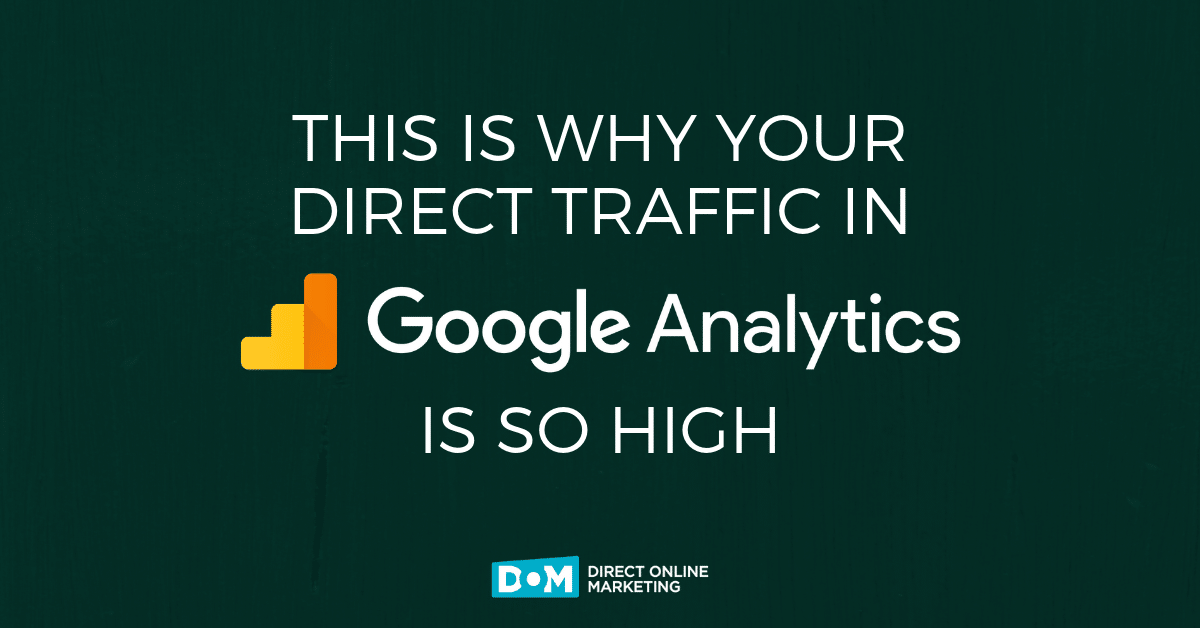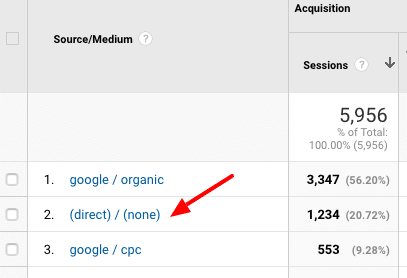
Editor’s Note: Looking for information on why you should be using Google Analytics? Are you still using the traditional version of the platform – Universal Analytics? You are at risk of losing any of your historical performance data in 2023 if you don’t set up and properly configure Google Analytics 4. Learn how the two platforms compare to each other in this blog post – Google Analytics 4 vs Universal Analytics.
So, What Is Direct Traffic?
Google Analytics displays traffic sources as (direct) when the arrival session data is missing, or when a referring website/source sets itself to go unreported.
First, let’s rule out referral sources that do not indicate where a visit originated. There’s no reason to focus on things we can’t control.
Here are the main Google Analytics sources you commonly come across:
- Direct
- Organic Search
- Social
- Affiliates
- Referral
- Paid Search
Depending on the type of site you operate, specific sources drive more or less traffic.
In most cases, direct traffic ranks high in default channel grouping. Because of the amount of (direct) traffic a site receives, many site owners elect to better understand what it is. The remaining sources should be obvious.
When Google Analytics has no clue how a session arrived at your site, it reports the source as direct.
Causes Of Direct Traffic in Google Analytics
Bot Traffic
Bot, or non-human artificial traffic sources, compromise a portion of direct traffic on many sites. Good or bad, this traffic is not the result of any marketing efforts.

One of Direct Online Marketing’s Senior Client Success Manager, Stephanie Mahnken, says she identifies bot traffic by comparing bounce rate and session duration stats.
“Look for a high bounce rate and low average session duration. Add a secondary dimension of service provider and city. There is a good chance that any traffic from Amazon located in Boardman, OR or Ashburn, VA are bots! Create filters or custom segments in GA and while you are at it, in the view settings be sure to check off ‘Exclude all known bots & spiders’.” Mahnken said.
Type-in Traffic
Many people assume type-in traffic as the cause of direct traffic. The assumption is mostly true; allow us to explain.
When someone types a website’s URL into their browser, it’s direct traffic.
But this is less strategic and cunning on the part of Google Analytics than we assume. That’s because a user typing in a website directly is a user without a source.
Direct traffic is type-in traffic, but only because it has no affiliated source. That means that type-in traffic is the most obvious cause, but hardly the most prominent one.
Ten to fifteen years ago, high type-in traffic reporting indicated a site’s success. When someone knew a site’s URL off the top of their head and typed it in, the site was winning.
But these days, there are many fewer instances of type-in traffic behavior. This is due to the popularity of social media and messenger platforms. Many people find their sites via Facebook, Twitter, or text message referrals. Often, people don’t realize what URL they are reading.
Additionally, search engines refer a lot of traffic as well.
The point being that people type-in domain names less now than ever.
This means there are other explanations. And that’s where things get more complex.
Hyper Text Transfer Protocol Secure (HTTPS)
Today, HTTPS is quickly becoming the standard web protocol. HTTPS encryption manages the secure connection between browser and website.
Several years back, Google indicated that HTTPS is their preferred protocol standard. Search engine optimizers did not hesitate in spreading the good word. Hundreds of thousands of sites were soon changing their sites from HTTP to HTTPS.
The immediate result was a safer web experience.
The not-so-immediate result?
Lots more direct traffic in Google Analytics.
Why?
When HTTPS refers a session to HTTP, with no referring data logs, Google Analytics reports this as direct traffic.
But wait, why?
Because that’s how HTTPS should work.
Let’s look at the bigger picture.
- When HTTPS refers a session to an HTTP page, there is no data logged. This results in direct traffic as the source.
- When HTTPS refers a session to HTTPS, referral data gets logged.
- HTTP to HTTP (data logs)
- HTTPS to HTTPS (again, this logs)
- HTTP to HTTPS (this logs)
Let’s imagine a real-life case.
We create a blog post on http://directom.com. Inside the blog post, we link to your fancy jewelry website, http://IcedOutReviews.com.
My blog post ranks high in Google and it’s quite popular. As a result, Iced Out Reviews gets hundreds of referring hits per day from Directom.com.
Then one day, we change http://directom.com to https://directom.com.
Iced Out Reviews remains HTTP.
Their Google Analytics now reports hundreds of direct traffic stats.
They become super confused.
But, upon further examination, Directom.com’s protocol change caused the influx of direct traffic.
Iced Out Reviews is in no position to resolve this matter, right?
Kind of, but not entirely.
Iced Out Reviews will need to first migrate from HTTP to HTTPS. Second, they’ll need to contact Directom.com and ask them to update their blog link to the HTTPS.
But wait, there’s more murky territory to explore.
What if Iced Out Reviews migrates from HTTP to HTTPS but doesn’t update their HTTP partner outbound links?
If Iced Out Reviews has partner deals with HTTP sites, those sites may assume they’re cut off.
In this case, Iced Out Reviews can install a meta referrer tag. By doing so, the partner sites will still log referral traffic from Iced Out Reviews.
Mahnken encourages site owners to make the switch to HTTPS. She feels this will help remedy the direct traffic issue for everyone.
“Hopefully, you have already made the switch to HTTPS. In case you didn’t know, Google now uses this as a ranking factor. If you haven’t, you better get going! If your site is already secure, make sure any links (social media profile/posts, press releases, guest posts, etc.)include the full secure link,” she says.
Redirect Gone Wrong
Site owners use redirects for many purposes. One of the biggest reasons to deploy a redirect is for SEO. Say you want to delete an old blog post, but keep the organic traffic. In this case, you might redirect the old blog post traffic to a more relevant, current blog post.
When changing domain names, you redirect the old domain traffic to the new one.
Here’s the thing: if you fail to set up a redirect properly, you might end up increasing direct traffic.
Javascript redirects and meta refresh redirects result in direct traffic.
We refer to another type of redirect traffic as “server-side.” A server-side redirect is popular amongst SEO pundits. This type of redirect can also result in direct traffic. This is often the result of UTM parameters getting lost in the process.
A solution might be manually adding in UTM parameters. This is tricky territory; it doesn’t always work, but it is a solution worth exploring.
So, if the server-side redirect is:
https://directom.com (server-side redirect to) https://icedoutreviews.com – you will get an influx of direct traffic.
The following is the correct way to attribute the referral source from a server-side redirect:
https://directom.com/?utm_source=google&utm_medium=organic&utm_campaign=redirect (server-side redirect to) https://icedoutreviews.com
You can use Google’s Campaign Builder tool to apply UTM parameters.
Document Referrals
The main takeaway here is that documents such as MS Word files and PDFs send direct traffic to links.
If you are a site that offers PDF eBooks with your links embedded, this can add direct traffic potential. When people download the PDF eBook and click your links, they cause direct traffic.
Just like before with server-side redirects, you can fix this by adding in UTM parameters.
Shortened URLs
Many people use URL shortener services such as Bitly to decrease URL length. By clicking or visiting shortened URLs, these services employ a redirect process.
To fix, you can deploy UTM parameters in the destination URL.
For example, if we wanted to create a vanity URL to share on Twitter, we could do so in Bitly.
If we use https://www.directom.com/data-studio-report-templates/, we end up with a direct traffic scenario.
But we could use (https://www.directom.com/data-studio-report-templates/?utm_source=google) instead. This would log referral data, thus eliminating direct traffic as a consequence.
Your Google Analytics Tracking Code Is Missing
Instances of websites missing Google Analytics tracking code isn’t as common as it once was. This is due to the popularity of templated code installation.
But it still happens. And when it does happen, direct traffic goes up.
Imagine you create a new page on your site, but you never deploy Google Analytics code on it. This can create direct traffic.
Here’s how this works:
A user hits a new About page on your site. The About page lacks Google Analytics code, or the code doesn’t fire. Now the user clicks the Contact page from your About page. The Contact page’s Google Analytics code works. The referring scenario logs as direct traffic because the About page’s tracking code is missing or broken.
Conclusion
Site owners are often bewildered by direct traffic stats. When we can’t interpret data, it slows down progress.
But sites receiving direct traffic can often look to a few scenarios to credit sources. The top two reasons for direct traffic are HTTPS migrations and redirect deployments. In both cases, a site owner can take steps to resolve.
Learn how to minimize your risk and maximize the success of your SEO site migration plan with our 7-step proactive checklist.
But direct traffic, to some extent, is something we must live with (at least for the time being).
Not all direct traffic is bad. It can be a good problem to have.
Do you have questions about whether PPC or SEO is right for you? Check out this video:
To get more information on this topic, contact us today for a free consultation or learn more about our status as a Google Premier Partner before you reach out.



